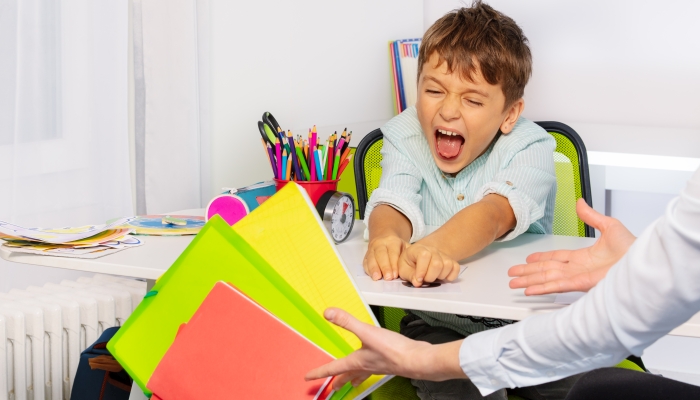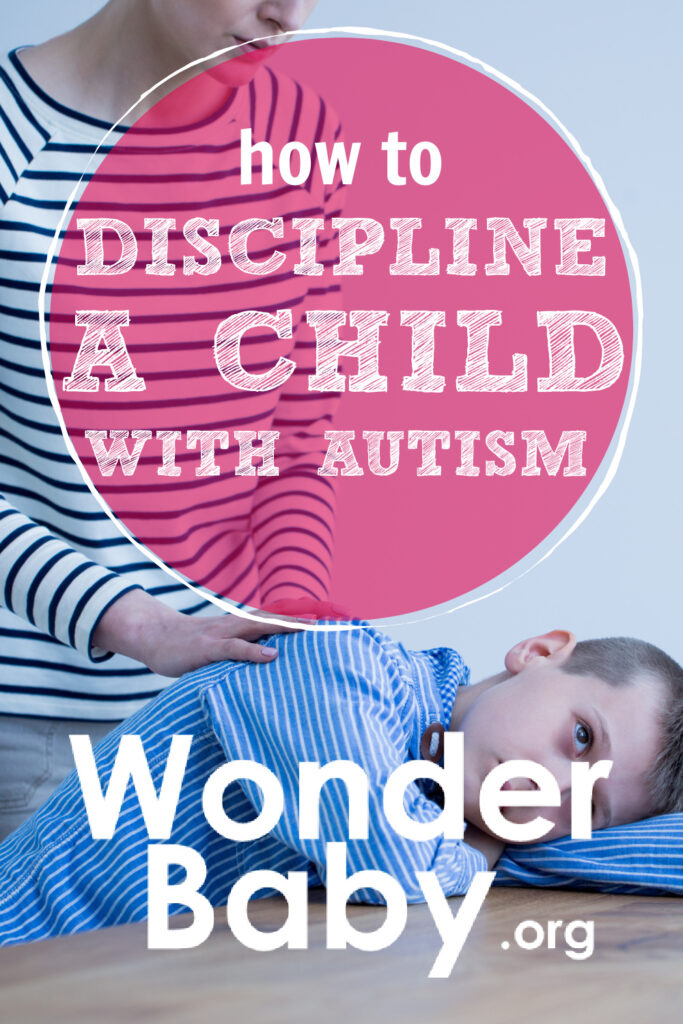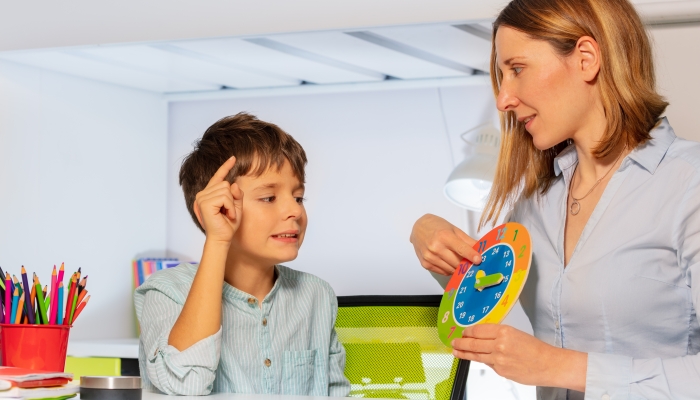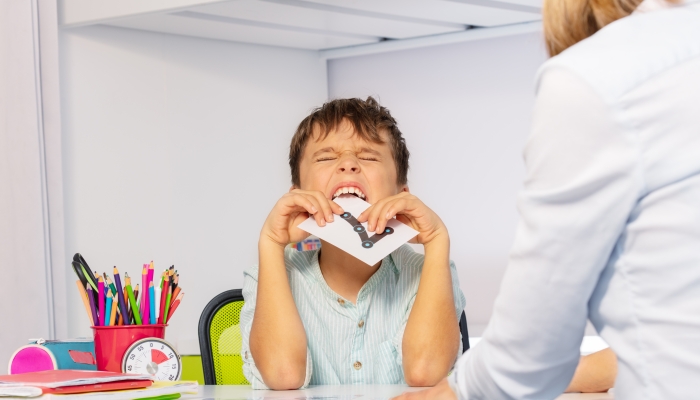How to Discipline a Child With Autism

- Children with autism thrive with consistent, gentle discipline techniques.
- Traditional discipline techniques are not as effective for children with autism.
- Discipline involves creating clear, appropriate expectations based on your child’s specific behaviors and needs.
- Seek help from a professional if you’re struggling to manage behaviors or reinforce skills you’re working on at home.
In the midst of a temper tantrum, your child hits you. You scold and try to redirect him but he ignores you and starts throwing toys. Maybe you take away privileges or send him to time-out.
Then it happens again and again. The meltdowns aren’t decreasing and you’re at your wit’s end. You find yourself scolding more, possibly even making threats that you’re not sure you will follow through on.
If you’ve attempted these strategies with your child with autism and feel like they are failing, you’re not alone.
Traditional discipline techniques are not as effective for children with special needs. Children with autism don’t always understand your tone of voice and may not understand you are scolding them. Some undesirable behaviors are common for children with autism and they might not be able to control them.
Learning different techniques for how to discipline a child with autism will help guide your child’s behavior.
When a child struggles with behaviors, gentle and consistent strategies are essential. Discipline strategies include focusing on a consistent routine and appropriate expectations.
The Importance of Rules and Discipline for Children With Autism
The goal of discipline, regardless of your child’s specific needs, is to teach expected behaviors by setting healthy limits and having appropriate expectations. Discipline is meant to teach kids the skills they need to live an independent life in the future.
If your child is on the autism spectrum, or if you think your child might have autistic characteristics, adjusting discipline techniques to fit their unique needs is more effective. To discipline a child, you must have appropriate expectations for their development, set clear rules, and be consistent.
Appropriate Expectations
All children are unique and develop at different stages. When children are young parents are often told not to compare children. This is especially true for children with autism spectrum disorder (ASD) because ASD can look very different for each individual.
Familiarizing yourself with your child’s specific diagnosis and behaviors is important. ASD is diagnosed by a mental health professional utilizing the diagnostic criteria in the Diagnostic and Statistical Manual of Mental Disorders (DSM-5) by the American Psychiatric Association.
There are common autistic behaviors, but a professional can share details regarding your child’s specific behaviors.
Common behaviors seen in autistic children include:
- Biting self
- Hand flapping, rocking, or other self-regulating movements
- Screaming or yelling
- Head banging or hitting head
- Not making eye contact
- Physical aggression (biting, spitting, kicking)
Although these challenging behaviors are not ideal, it’s crucial to understand that your autistic child might not be able to control these behaviors. Some of these behaviors will not change with punishment.
Discipline strategies for these negative behaviors involve focusing on why a child is acting out and reducing triggers to avoid the behavior.

Create Rules
Setting healthy limits, or boundaries, helps children be successful. The best way to set limits is by creating clear rules for your household.
Rules outline expected behavior and create structure in the home. When creating rules, communicate clearly and directly what is expected. Use plain language for your child to understand.
Specific rules guide children and explain what your child can do instead of what not to do.
| Instead of the rule: | Try saying: |
| No hitting. | We use gentle hands. |
| No running. | We walk inside. |
| No yelling. | We use quiet voices inside. |
| No being mean. | We are kind to others. |
Create rules for current behaviors that your child is struggling with. Be clear and concise. Create rules together as a family and display them within your home for everyone to see.
Be Consistent
Children, especially children with autism, crave consistency and order. Having clear, outlined rules and following through with discipline will help reduce behaviors. Children with autism desire routines and do well with structured and consistent discipline.
It’s common for children with autism to also have some anxiety. Knowing what to expect can help reduce anxiety. When enforcing a limit or consequence, follow through as consistently as possible.
Strategies For Disciplining a Child With Autism
There are several discipline strategies that can help your child with autism. It’s important to remember that when disciplining your child to remain fair, firm, consistent, and kind.
Model Self-Regulation
Most adults have learned different self-regulation techniques and are able to implement them in times of need. Children, however, are learning these important skills and still rely on adults to help guild them to self-regulate.
This is called co-regulation. When an adult remains calm during a child’s escalated behavior the child has a greater chance of becoming calmer as a result.
Neuropsychiatrist and author, Dr. Daniel Siegel, and parenting expert Tina Payne Bryson, Ph.D., discuss the importance of co-regulation during discipline in their book, No Drama Discipline.
They encourage parents to try and remain calm while disciplining children. When a child is upset, the child needs you to stay calm to help them self-regulate. It’s very difficult for a child to calm down when a parent is not calm.
In the midst of a tantrum or other negative behavior, take care of yourself. Take deep breaths, give yourself a time-out (if it is safe for you to step away from your child), or ask for another person’s help. As a parent, prioritize your self-care. Doing so will help you remain calmer in stressful situations.
Teach Self-Calming Strategies
Teach your child self-calming techniques during times of play and positive behaviors. Children need to practice new skills over and over in order to master them.
Try some of these:
- Give opportunities for your child to practice breathing in and out. Use creative ways, such as pretending to blow a bubble or cool down a pretend piece of hot pizza, as practice for breathing techniques.
- If your autistic child responds well to physical touch, offer gentle hugs with steady pressure. Weighted blankets, appropriate for your child’s size, can also offer steady pressure that is calming. When your child is struggling with inappropriate behavior, offer to wrap them in a blanket or offer a gentle squeeze.
- Sensory stimulation, such as swinging or rocking, can also help children with autism. Creating a specific space in your home, sometimes referred to as a sensory room, can be used as a tool during discipline. Instead of time-out encourage your child to utilize different sensory toys or a sensory swing in their specified calm space.
- Create a visual chart with different self-calming strategies that work for your child. During times of stress, ask them what activity they feel they need.
Rewards and Consequences
Many children respond well to positive reinforcement for positive behavior. Positive reinforcement includes offering incentives and rewards for desired behaviors.
Positive reinforcement strategies can help a child with autism focus on the desired behavior. When using positive reinforcement, it’s helpful to identify certain behaviors you are wanting to see (such as being gentle with a sibling).
When you notice the desired behavior, offer praise, a high five, or another immediate reward. Sticker charts can be effective for some children. However, children with autism respond better to more immediate rewards.
Consequences are an effective discipline tool for negative behavior when used appropriately. Consequences are either logical or natural. Natural consequences happen on their own (you tip your chair back and you fall), while logical consequences have to be enforced (you throw a toy and you lose it). Natural consequences are more effective than logical consequences.
Logical consequences work best when thought out in advance, are quick, and are consistently enforced. For example, if your child is hurting other children, the consequence might be removing them from the situation and having them choose a self-regulation technique. Logical consequences are not the same as physical punishment.
Set Clear Expectations
Discipline works when children know what to expect. Set clear, realistic expectations with visual rules and cues throughout your home. Practice desired behaviors with role play.
Focus on setting your child up for success by limiting triggers. If you know your child is easily overstimulated, reduce the amount of time in overstimulating environments. Plan ahead and bring noise-canceling headphones to reduce sensory overload.
Instead of temper tantrums, your child might have sensory meltdowns. Focus on prevention techniques or other calming strategies, not punishment, to guide your child during these meltdowns.
Be Positive
Focus more on good behavior than bad behavior. Just like tending to a garden, what you water and nurture will grow. If you focus on the weeds, you’ll have more weeds. Instead, focus your attention on the flowers so they will grow and bloom.
When a child is struggling with problem behaviors, if you continually focus on the problem, it will more than likely continue to grow. Focus on what you want to see instead. Offer specific and descriptive praise when you see the desired behavior. Avoid general praise such as “good job” and instead be descriptive such as “good job keeping your hands to yourself during dinner.”

What to Avoid When Disciplining Your Child With Autism
When disciplining your child with autism, it’s important to avoid verbal and physical punishments. Physical punishment can have a negative effect. It does not teach your child what to do but instead can cause confusion, fear, or escalate violent behaviors.
Verbal punishments like scolding or yelling are also not effective. Many children with autism don’t understand social cues or tone of voice. They might not understand they are even in trouble.
When interacting with your child, especially during discipline, avoid telling your child to “look at me.” Although eye contact might be a value to your family or a sign of listening to some people, know that most children with autism may not be able to make eye contact.
Trying to make your child make or maintain eye contact is an unrealistic expectation and it is setting them up for failure. Instead, focus on being close to your child when disciplining. Connect through gentle touch instead of eye contact.
Remember, your goal for discipline is not to change behaviors they may struggle to control but instead focus on understanding and reducing triggers that escalate negative behaviors.
When to Seek Professional Help
If you are finding it hard to manage your child’s behavior it can be extremely helpful to seek professional medical advice. Children with autism benefit from intensive therapy. Therapy reinforces what you are working on at home. It is helpful to create a treatment team of individuals that support your child and your family.
Support might include your pediatrician, a psychiatrist, your child’s school, a mental health therapist, an occupational therapist, or a physical therapist depending on your child’s unique needs. Seek support from other parents when possible too.
Work together with your child’s treatment team to create a plan that works best for your child. Your struggles or concerns at home might not be the same at school. Speak up and advocate for your child and for your family’s needs. Create a treatment plan that not only will support your child but will also work in your home.
Parenting a child with autism can be both joyous and overwhelming. Your child will thrive in a structured and supportive environment with gentle and consistent discipline.

Related Posts

Autism
Developing Time Management Skills in Children with Autism: 7 Tips
Learn how you can use structure and visual aids to help your child with autism learn time management skills.

Autism
Occupational Therapy for Children with Autism: How It Can Make a Difference
Children with autism face challenges in many different areas. Occupational therapy can help children address these difficulties while having fun!

Behavior
Understanding Intermittent Explosive Disorder in Children
Are you worried about your child’s unexpected aggression and explosive behaviors? Learn how to support a child with intermittent explosive disorder.